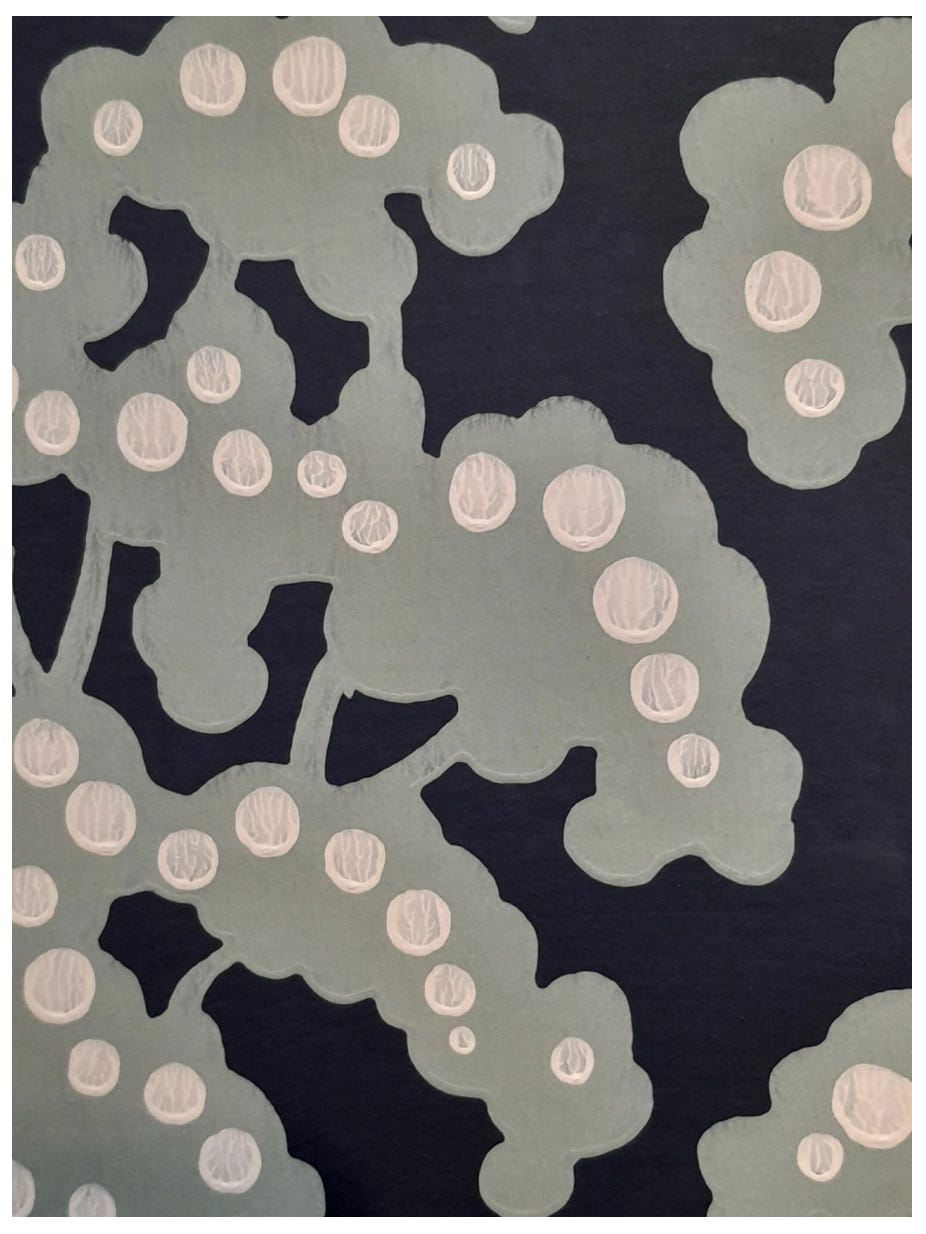My artist sister Amy, whose memory I am celebrating this week on Roughhousing, spent many years learning color. Unless you are vision impaired (low-vision, no vision, color blind, etc.), you might take it for granted that you understand color; that you can tell your pinks from your grays and so on. Apropos of this, Amy once told me an anecdote:
She was working on recreating, in gouache, a piece of historic wallpaper (probably for Ralph Lauren, where she worked as a textile and wallpaper designer). She needed to match the colors exactly, so the company could recreate the pattern for one of their products. She was trying to match a highlight in the floral design - a bright pink, and she just couldn’t get it. The more she mixed the colors, the more garish it appeared. Eventually she got there. “It was gray!” she said. The pink was gray - a pinkish gray that appeared like a juicy pink highlight due to the colors that surrounded it.
A similar effect to this:

This is an example of what Josef Albers called “the relativity of color”, and it is the sort of deep-art-geek visual understanding that you develop when you look carefully, and experiment for 10,000 hours or so. It can also lead to an appreciation for qualities of surface, such as luminosity, dullness, sheen and - in Amy’s case - the joys of patterns well rendered and well printed.
I first learned about Farrow and Ball wallpaper when Amy chose it for our mother’s dining room. It was a fairly quiet pattern, in gray and off-white, noticeable not because it called attention to itself, but because it looked like something nice - something of fancier quality than I was accustomed to seeing in the family home.
To paper a moderate sized room with Farrow and Ball will cost, on average, about $2,500 for the wallpaper alone. Your typical rolls of wallpaper available on Amazon, in similar proportions to Farrow and Ball rolls, will cost $80 - Farrow and Ball rolls cost $350.
There is a reason for the difference in price: while most wallpapers are mass produced in ink, Farrow and Ball papers are printed with paint that is pressed onto the paper with hand-carved wood or linoleum blocks, using traditional machines. Each color is printed separately: the background is laid on first, then however many colors that constitute the pattern. I found a good photo of this on a wallpaper blog:

Farrow and Ball also sell paint, in a limited number of highly curated colors. It’s the difference between choosing from this:
And this:

In addition to selling paint and wallpaper, Farrow and Ball is selling a “look”. You can pay quite a bit of money for that look, and if you have the cheddar, I would argue that it is worth it.
But for those who lack the funds, there are workarounds. The first one might seem obvious, but before Amy told me about it, I had not figured it out for myself. “You just bring a Farrow and Ball color sample to the hardware store and have them mix it in whatever brand of paint you can afford.” Sure, the result might lack what Farrow and Ball paint offers in the quality of the surface, but you will still get the color - or at least a close match. And if you order yourself a $35 color fan, you could play around with combinations and test out different colors on different surfaces in your house, then take your color samples to Home Depot and cheap out on some Glidden.
For the wallpaper, you have to rely on other people’s miscalculated projects: leftover wallpaper on ebay. There you can find Farrow and Ball wallpaper, in limited patterns and amounts, generally for half the original price. Some other ways to reduce cost: paper a small area - paper above or below the chair rail, paper a small bathroom or a single wall in a room.
Amy, who was a master at finding high-end products on sidewalks and at thrift stores, rural auctions and dumps, used her color knowledge and sourcing sense to create beautiful rooms for minimal cost. I don’t think this is easy for everyone to do - even if you have the high-quality color samples, picking out the right combinations is its own art. I am a visual artist, and I am not very good at it. Amy was an artist specializing in color - she knew how to handle a pile of paint samples.
Farrow and Ball offers the services (for hire) of its own team of color specialists. Alternately, a guide book would be a less expensive option. Farrow and Ball offers several that are available on Amazon, where I also found this book, well rated by over 1,000 readers:
I purchased one for myself, as Amy is no longer available for consultation and it is unlikely that I will dedicate the same amount of time and focus to color study as she did. For my next room painting project, with the Pantone guide and the Farrow and Ball color samples, I might just be able to put together something nice. Though I will probably want to render it in Milk Paint.
FULL DISCLOSURE! Sometimes I include Affiliate Links in my articles. This means that if you purchase an item from these links, I will receive a small commission. I only ever recommend items or companies that I have used and am VERY happy with - and if I ever link to an item that I haven’t used, I make this clear in the article.






